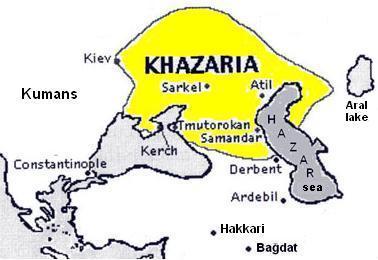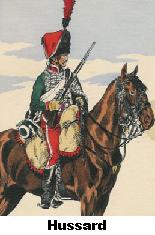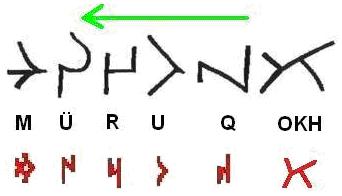|
The Khazar Empire came into being
during the 5th century AD and lasted until the 13th
century AD. It was destroyed by the unforgiving onslaught and
expansion of Cengiz Khan towards the west. The territories of
the Khazar Empire shown below extended from the north-western
regions of the Black Sea up to and including the northern
banks of the Caspian Sea. The name of the Caspian Sea is a
transformed form of the harsh laryngeal Khazar, to the smooth
labial Caspian form. Khazar
is clearly made out of
OKH-AS-ER meaning “the Okh and As people” (see
Chapter 4, The Asiatic
Scythians). Today a country named Azerbaijan still
exists on the western side of the Caspian Sea whose name has
been dissected as AS-ER-BAY-JAN meaning
“The spiritual leadership of the
As people” in Chapter 4. Therefore, Khazaria means “the
country of the Okh and As”.

The Khazar people belonged to a grouping of Turks who spoke a
Turkic dialect and used the runic alphabet of the Orhun
syllabary belonging to the Gökturks of central Asia. The
ancient Turks defined the four directions, north, south, east
and west with the help of colors. West was blue, east was
yellow, north was black and south was white. Considering their
location in Asia one can easily realize the reason of such
color selections. “Gök” was a word meaning “sky” or “heaven”
as well as “blue” and “west”. So, in the name Gökturk we find
several meanings such as “western Turks”, “blue Turks” and
“heavenly Turks”. The royalty of the Khazars was descended
from the Ashina (Asena) or
AS-ANA Turks, which was most probably a matriarchal
society. Since As-Ana means “As Mother” we can safely guess
that they were culturally and most probably genetically
related to the Scythians and Amazons who lived in the same
region some centuries ago (see Chapter 33,
Western Anatolia).
Kiev, which
is the capital city of Ukraine was established by the Khazars.
Kiev is a name concatenated from two Turkish words
Kiyi and
Ev
meaning “shore house”; a name quite appropriate for the
ancient settlement which is located on the shores of the
Dnipro River. As the Christian Russians from the west and the
Islamic Arabs from the south increased their attacks towards
Khazaria, the royalty who believed in Tengri, decided to adopt
the monotheistic religion of Judaism. In this selection they
hoped to remain free of the physical as well as the spiritual
pressure of the surrounding powers. The Khazars were ruled by
a succession of Jewish kings until the Mongols came from the
east and destroyed their cities. As the Khazar Empire came to
its end the Khazars dispersed in all directions and formed
local communities in Hungary, Germany, Lithuania, Ukraine and
Ossetia. Since Khazar males were expert riders –a cultural
trait handed over from their ancestral Turkic origin- they
formed the elite light cavalry of most western armies. These
riders came to be known as the Huszar in Hungary and the
Hussard in France. There is a city called Khusar-Kintsag in
northern Caucasus, which was probably founded by the ancient
Khasars. Below we see a representation of a Hussard. The tall
hat is a transformed form of the Asiatic “kalpak”.

The word
shown below has been given as an example for the Khazar script
and has been interpreted as OKURUM, meaning “I read it” in
modern Turkish (1).

The script
has to be read from right to left, similar to all Orhun texts
which have been written in that order. The black letters at
the top are the Khazar letters and the red ones under them
belong to the Orhun syllabary. The first letter on the right,
which is not found among the Orhun letters, might be
considered as being influenced from or related to the Roman K.
Here are
three example sentences in the Khazar language. They clearly
demonstrate their Turkic origin, since their meaning is still
understandable with the help of modern Turkish.
Kaytmamen artkari sezimden.
(I
never come back from my word)
Da algýshladi allarni
tangri
(and God
‘supported / praised’ them)
It is
interesting to note that the word “algýsh” or “alkýsh” means
“hand-clapping” in Turkish, an act of joy and support for
praising a completed performance.
Sendir otnu suvba,
yamanlikni dostlukba.
(Extinguish
the fire with water and the adversity with friendship)
|